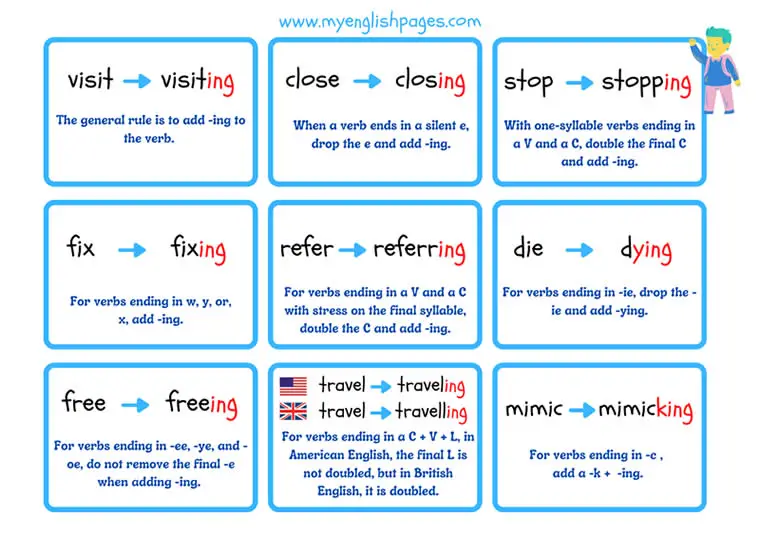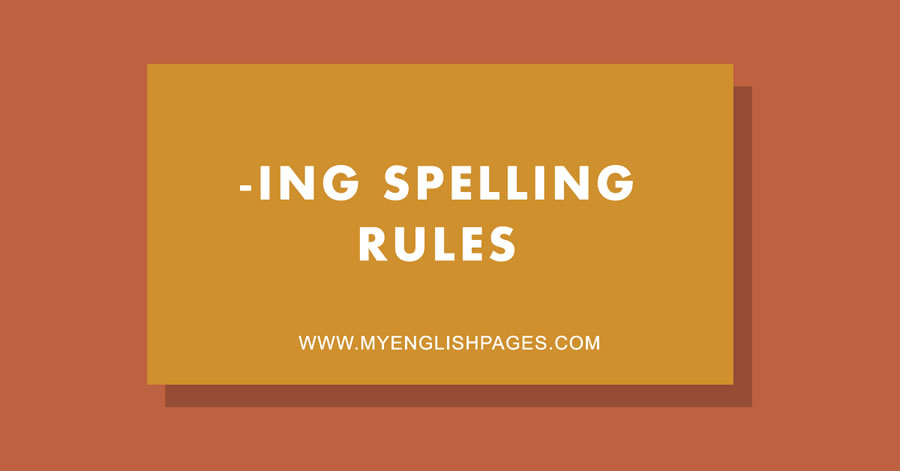Master the ING forms with these 9 essential -ING spelling rules! Learn when to double consonants, drop silent “e,” and more for accurate verb endings.
Table of Contents
When is “-ing” added to the verb?
We add -ing to continuous verb forms and gerunds.
Examples:
- She is in her bedroom. She is doing her homework.
- I like fishing.
If you are in a hurry, here is a summary of 9 rules to help you with the ing form spelling. If you need detailed explanations, continue reading after this summary of the rules.
When adding the “-ing”, we have to follow special spelling rules.
- The general rule is to add -ing to the verb. For example, for verbs like wait, visit, speak, add only -ing (i.e., waiting; visiting, speaking.)
- When a verb ends in a silent e, we drop the e and add -ing. For example, close becomes closing.
- For verbs with one syllable and ending in a vowel and a consonant (e.g., run, stop, hit), double the final consonant and add -ing. For example, hit becomes hitting.
- For verbs ending in w, y, or, x, we only add -ing. For example, fix becomes fixing.
- For verbs ending in a vowel and a consonant with the stress on the final syllable (e.g., refer, forget), double the consonant and add -ing (e.g., referring, forgetting.)
- For verbs ending in -ie, drop the -ie and add –ying. For example, die becomes dying.
- For verbs ending in –ee, –ye, and –oe, do not remove the final –e when adding -ing. For example, the verbs free, dye, and tiptoe, become freeing, dyeing, and tiptoeing.
- For verbs ending in a consonant + vowel + L, one of 2 rules apply depending on whether you are using American or British English.
In American English, travel becomes traveling while in British English it becomes travelling. - For verbs ending in -c , we add a -k + -ing.
For example, mimic becomes mimicking when we add -ing.
What are the ing spelling rules?
The spelling rules that govern the formation of continuous verbs and gerunds may be confusing. The spelling changes according to verb endings and the number of syllables. The following sections explore nine spelling rules to master the spelling of ing forms.

1. General rule
The general rule is to add -ing to the verb. To illustrate, for verbs like:
visit, watch, sing, do, wait, work…
add -ing to the verb.
Examples:
- Working on the computer can cause eyesight problems.
- I am working on a new project
| do | + | ing | doing |
| go | going | ||
| eat | eating | ||
| look | looking | ||
| read | reading | ||
| sing | singing | ||
| speak | speaking | ||
| visit | visiting | ||
| wait | waiting | ||
| watch | watching | ||
| work | working |
2. Verbs ending in silent e
When a verb ends in a silent e, we drop the e and add -ing.
Example:
- Making tea is not difficult.
- Nancy is in the kitchen. She is making tea.
| close | + | ing | closing |
| take | taking | ||
| hate | hating | ||
| love | loving | ||
| dine | dining | ||
| make | making | ||
| move | moving | ||
| create | creating | ||
| write | writing |
3. One-syllable verbs ending in a vowel and a consonant
For verbs with one syllable ending in a vowel and a consonant (e.g., run, stop, hit), double the final consonant and add -ing.
Examples:
- Running early in the morning makes me feel happy.
- Look at that woman. She is running as fast as she can.
| cut | + | ing | cutting |
| hit | hitting | ||
| run | running | ||
| sit | sitting | ||
| sob | sobbing | ||
| stop | stopping | ||
| swim | swimming | ||
| tap | tapping | ||
| win | winning |
4. Verbs ending in w, y, or, x, we only add -ing
For verbs ending in w, y, or, x, we only add -ing.
Examples:
- Fixing this computer is easy.
- They are fixing my computer.
| bow | + | ing | bowing |
| fix | fixing | ||
| know | knowing | ||
| lay | laying | ||
| mix | mixing | ||
| pay | paying | ||
| say | saying | ||
| snow | snowing |
5. Verbs ending in a vowel and a consonant with stress on the final syllable
For verbs ending in a vowel and a consonant with stress on the final syllable (e.g., refer, forget, happen), we double the consonant and add -ing.
Examples:
- Referring to my article was nice of him.
- Are you referring to this car or that one?
| admit | + | ing | admitting |
| begin | beginning | ||
| forget | forgetting | ||
| prefer | preferring | ||
| refer | referring | ||
| regret | regretting | ||
| submit | submitting | ||
| upset | upsetting |
6. Verbs ending in -ie
For verbs ending in -ie, drop the -ie and add –ing.
Examples:
- Lying to me was not kind of him.
- Listen! He is lying to us again!
| die | + | ing | dying |
| lie | lying | ||
| tie | tying | ||
| vie | vying |
7. Verbs ending in –ee, –ye, and –oe
For verbs ending in –ee, –ye, and –oe, do not remove the final –e when adding -ing:
| free | + | ing | freeing |
| dye | dyeing | ||
| hoe | hoeing | ||
| tiptoe | tiptoeing |
8. Verbs ending in consonant + vowel + L
For Verbs ending in consonant + vowel + L, two rules apply depending on whether you are using American or British English. In American English, the final L is not doubled, but in British English, it is doubled.
Examples:
- Traveling/Travelling to Paris is my dream.
- They are traveling/travelling to Paris next month.
| model | + | ing | modelling (UK) | modeling (US) |
| equal | equalling (UK) | equaling (US) | ||
| quarrel | quarrelling (UK) | quarreling (US) | ||
| travel | travelling (UK) | traveling (US) |
9. Verbs ending in -c
For verbs ending in -c, we add a -k + -ing.
Examples:
- Mimicking my brother is a lot of fun.
- He is mimicking his brother.
| frolic | + | ing | frolicking |
| panic | panicking | ||
| mimic | mimicking | ||
| traffic | trafficking |
Related Pages:


